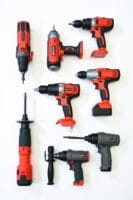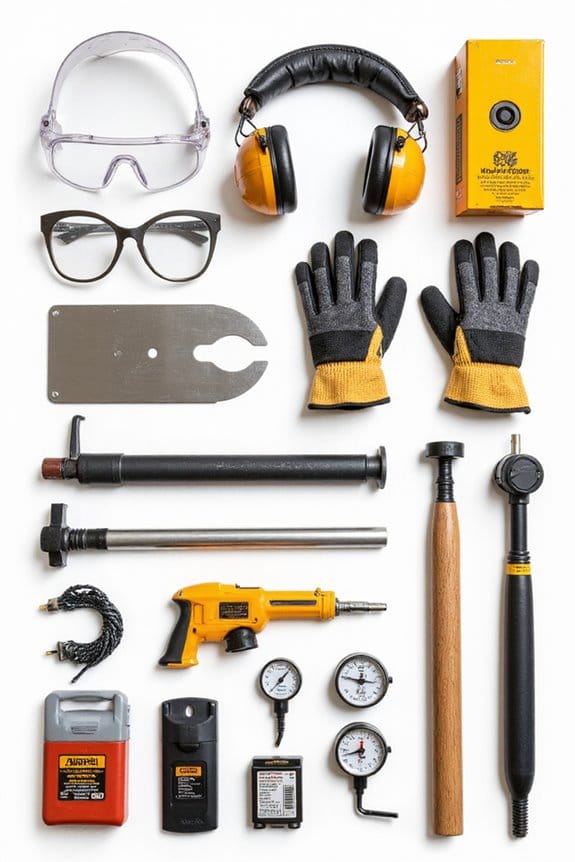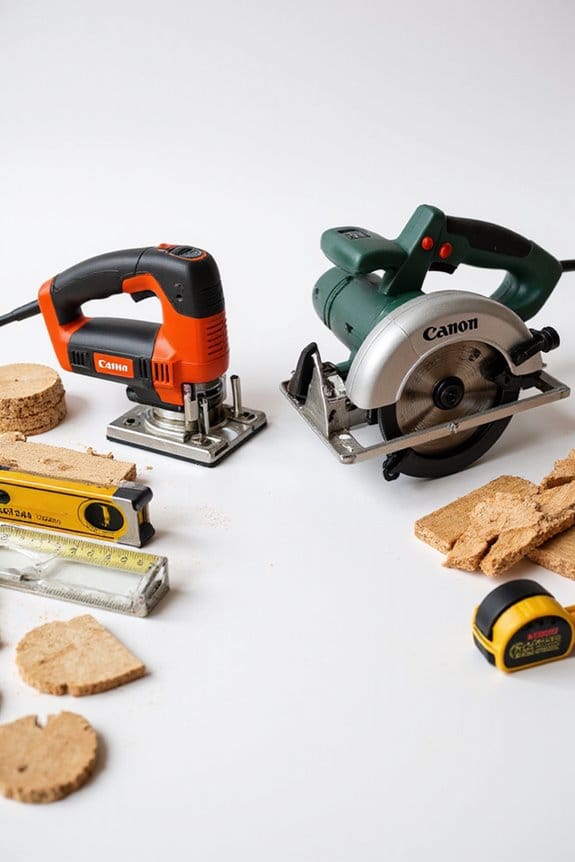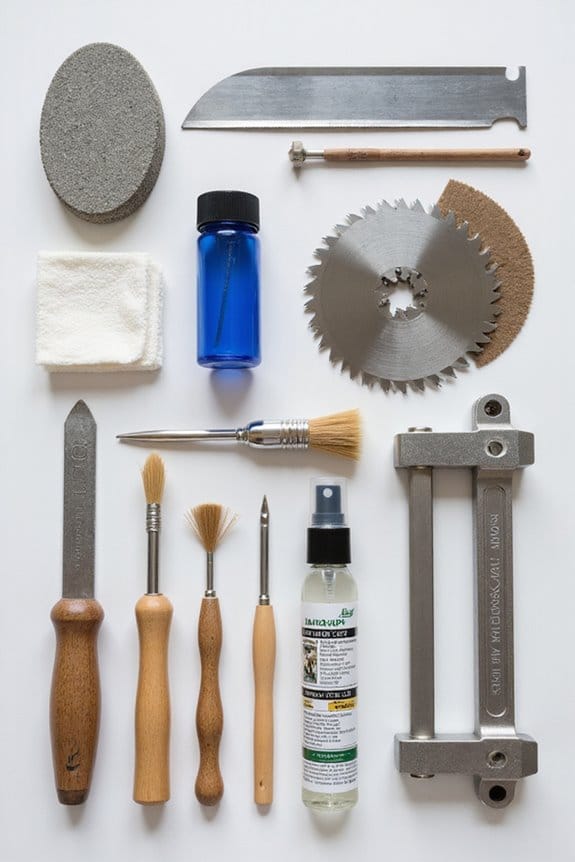When I started woodworking, I quickly learned that circular saws, jigsaws, and miter saws are great for beginners. Here’s why: 1) Circular saws are versatile and perfect for large wood pieces. 2) Jigsaws let you create curves easily, adding flair to your projects. 3) Miter saws help with precise angles, especially useful for framing. Their simple controls and comfortable grips make them user-friendly. Stick around, and you’ll discover even more tips for choosing the right saw for your journey!
Key Takeaways
- Circular Saws are versatile and ideal for beginners, allowing for straight cuts on larger wood pieces with ease of use.
- Jigsaws are perfect for cutting curves, making them great for creative projects and beginner-friendly applications.
- Miter Saws offer precise crosscuts and angled cuts, enhancing accuracy for framing and molding tasks.
- Hand Saws, like rip and crosscut saws, help develop essential skills and are easy to control for novice users.
- Look for saws with ergonomic handles, moderate TPI, and safety features to ensure comfort and security during use.
Overview of Beginner-Friendly Saws
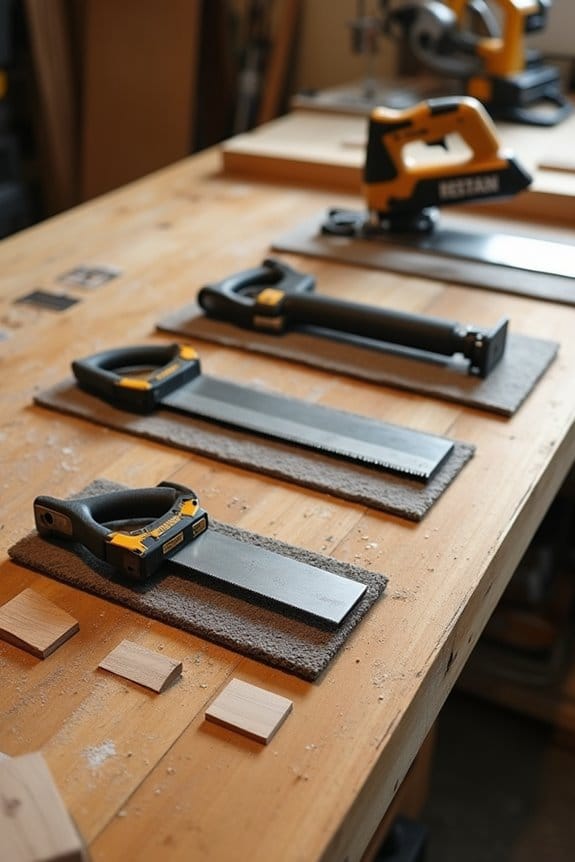
When starting out in woodworking, it’s essential to know the right tools to use. Here’s a quick overview of beginner-friendly saws to help with your saw selection:
- Circular Saws: Versatile and portable, perfect for straight cuts on larger wood pieces.
- Jigsaws: Great for cutting curves—ideal for those creative beginner projects.
- Miter Saws: Excellent for making precise crosscuts and angles, especially useful in framing.
- Table Saws: Perfect for long, straight cuts and ripping large sheets of material.
- Hand Saws: Traditional and simple, like rip saws and crosscut saws, they’re great for developing skills.
Each of these saws can help you tackle various beginner projects while building your confidence. Trust me, you’ll get the hang of it!
Characteristics of Ideal Saws for Novices
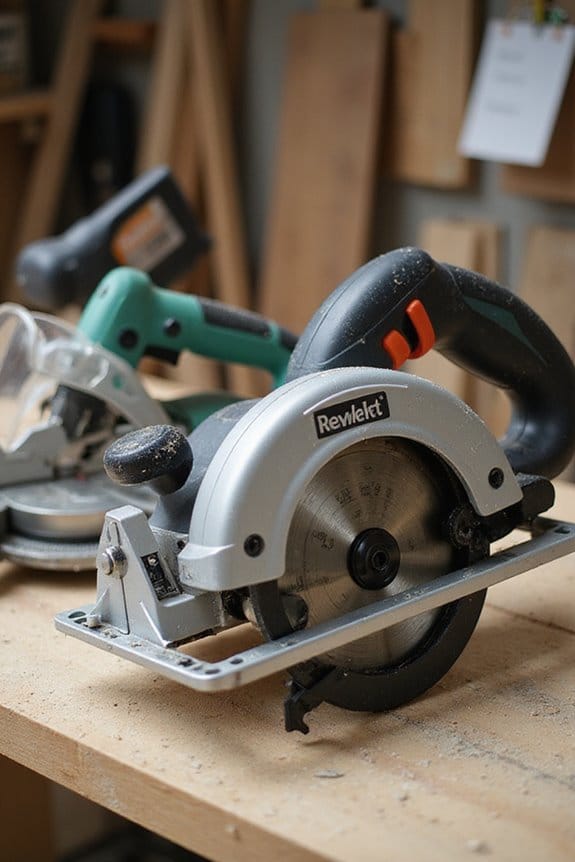
Choosing the right saw as a beginner can feel overwhelming, but knowing what characteristics to look for can make it much simpler. Here are some key traits to take into account:
- Blade Types: Opt for moderately flexible blades that resist bending but allow for control. A shorter blade offers precision, while a longer blade is great for bigger cuts.
- Grip Comfort: An ergonomic handle is vital. Look for one that feels good in your hand and allows for a secure grip to reduce fatigue.
- Tooth Design: A moderate TPI (8-12) gives smooth cuts without being too aggressive, helping you build confidence.
With these features in mind, you’ll be ready to tackle your projects without feeling like you’re wrestling with the saw!
Power Saws Suitable for Beginners
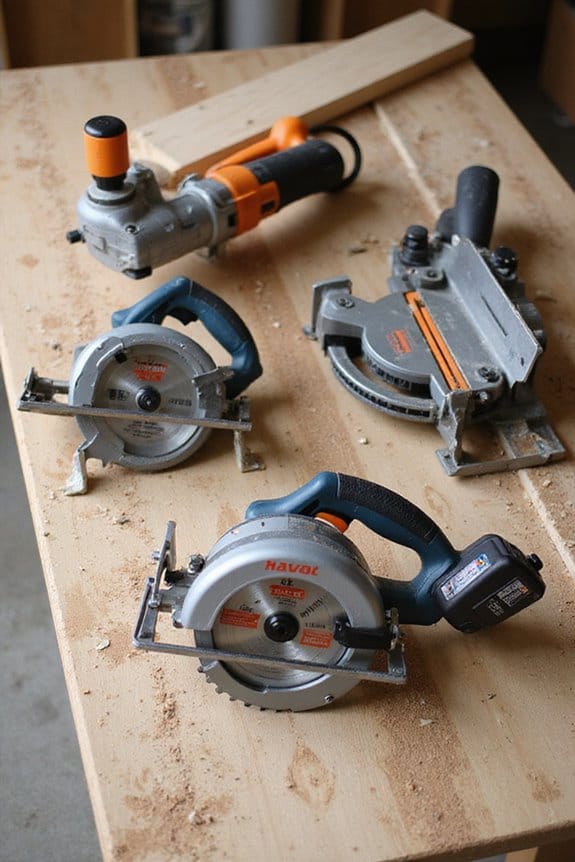
Power saws can be a game-changer for beginners, especially if you’re enthusiastic to plunge into DIY projects. Here are a couple of power saw types that I think suit newbies perfectly:
- Circular Saws: These are super versatile! The Skil 5280-01 is affordable and performs well. Plus, changing saw blade options is a breeze.
- Sliding Miter Saws: If you’re looking for precision, these are fantastic. They make angled cuts easy and are great for molding.
When choosing between cordless and corded, consider mobility versus power. Cordless models like the Bosch 18V offer freedom, while corded saws provide consistent power. Remember, the right saw can make your DIY journey much more enjoyable!
Common Hand Saw Types and Their Uses

Hand saws may seem old-fashioned in our power tool era, but they’re invaluable for beginners and seasoned pros alike. Here’s a quick rundown of common hand saw types and their uses:
- Ripping Saw: Great for cutting wood parallel to the grain. It’s aggressive and quick but leaves a rough edge—perfect for breaking down lumber.
- Crosscut Saw: Ideal for cutting across the grain. With a finer finish, it’s my go-to for trimming lumber.
- Panel Saw: A smaller version of the crosscut saw, it’s perfect for tight spaces.
- Coping Saw: Best for intricate cuts and curves, great for detailed work.
- Back Saw: Excellent for precise cuts, especially in joinery.
Choosing the right saw depends on your project and cutting techniques!
Key Features to Look for in Beginner Saws
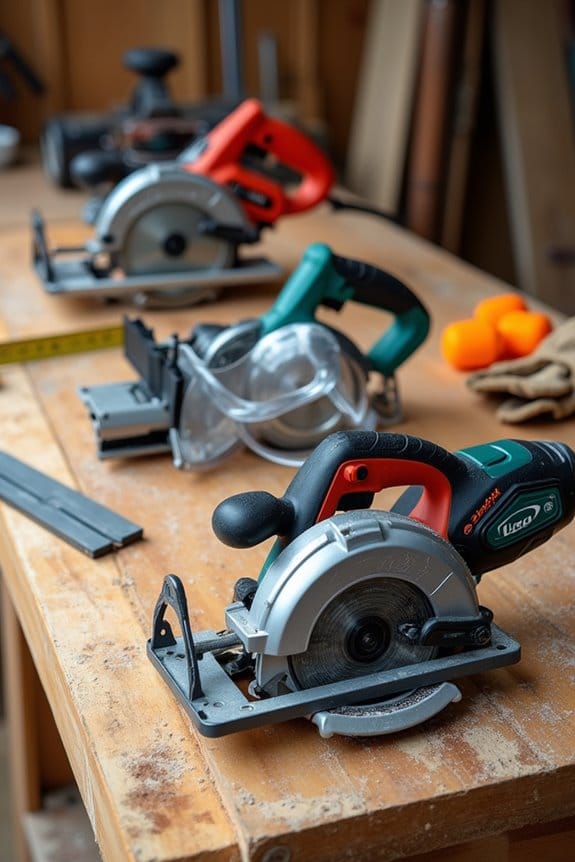
When diving into the world of saws, beginners should pay attention to a few key features that can make all the difference in their woodworking journey. Here are the essentials:
- Ease of Use: Look for lightweight designs and ergonomic handles. They reduce fatigue and improve control. Simple controls are a must!
- Versatility: Choose saws that support various cutting techniques, from straight cuts to bevels. Compatibility with different blade materials is a bonus.
- Safety Features: Integrated blade guards and non-slip bases protect you from accidents. Trust me; you’ll want these!
- Power Source: Decide between corded for constant power or battery-powered for mobility.
- Affordability: Start with budget-friendly options that still offer durability and value. Happy sawing!
Recommended Handsaws for New Woodworkers
Choosing the right handsaw can feel a bit overwhelming, especially for new woodworkers enthusiastic to plunge into their projects. Here are some recommended handsaws to evaluate:
- Japanese Saw: These feature thin blades, cutting efficiently with a pull stroke. The dozuki and ryoba saws are fantastic for fine woodworking.
- Dovetail Saw: Perfect for precise cuts like dovetails, with a tooth count of 14-16 tpi, making them great for beginners.
- Crosscut Saw: With a medium tooth count of 10-12 tpi, these are versatile for larger projects.
- Coping Saw: Ideal for intricate shapes and curves, and easy to handle.
Using these saw selection strategies will boost your confidence in beginner woodworking techniques. Additionally, investing in quality tools will enhance your overall woodworking experience. Happy sawing!
Best Power Saws for Beginners
After getting familiar with handsaws, many beginners find themselves enthusiastic to explore the world of power saws. Here are my top picks for power saws that are beginner-friendly:
- Circular Saws: Versatile for straight cuts. I recommend the Bosch 18V Cordless model for its portability and speed settings.
- Miter Saws: Great for precise angle cuts. The DeWalt 12-Inch Sliding Compound is a favorite for its accuracy.
- Jigsaws: Perfect for curved cuts. Look for Bosch models—they’re easy to use!
- Reciprocating Saws: Ideal for demolition but take some getting used to.
When choosing, consider saw types and blade materials carefully. Additionally, look for saws with high power ratings to ensure they can handle various tasks effectively. Safety features and weight play roles, too. Happy cutting!
Understanding Saw Teeth and Their Functions
Understanding the intricacies of saw teeth can transform your woodworking experience. I’ve found that knowing the different tooth shapes really boosts cutting efficiency. Here’s a quick breakdown:
- Rip Teeth: Chisel-shaped for cutting along the grain—perfect for ripping wood.
- Crosscut Teeth: Beveled edges give smooth cuts across the grain, ideal for fine woodworking.
- Fine Teeth: High TPI for detailed work, think of hacksaws.
- Coarse Teeth: Larger and spaced for rough cuts through thick materials.
- Universal Teeth: A versatile mix, great for various carpentry tasks.
Experimenting with these different teeth helped me find the right saw for each project. So, get familiar with tooth shapes, and you’ll notice a difference in your work!
Safety Considerations When Using Saws
Safety should always be top of mind when using saws, especially for beginners like us. Here are some key points for saw safety and injury prevention:
- Use Safety Features: Always keep blade guards and anti-kickback devices in place. They’re there for a reason!
- Stay Focused: Distractions can lead to accidents. Keep your eyes on the task at hand.
- Avoid Removing Safety Devices: It might seem tempting, but disabling safety features increases your risk of injury dramatically.
- Get Educated: Take the time to learn proper saw operation and hazard recognition. Trust me, it’s worth it.
- Inspect Your Tools: Regularly check that safety devices are functioning well; it’s a small step that can save you big trouble.
Tips for Maintaining Your Beginner Saws
Maintaining your saws isn’t just about keeping them clean; it’s also a way to guarantee they serve you well for years to come. Here are some key maintenance practices I recommend:
- Saw Cleaning: After each use, vacuum sawdust and debris to prevent buildup. Use a Scotch-Brite pad for hand saw blades and clean circular saw components thoroughly.
- Lubrication: Apply WD-40 or paste wax to metal parts and wooden handles. Just don’t go overboard—too much can attract dirt!
- Blade Maintenance: Regularly check blade sharpness and adjust tension as needed. Dull blades make your job harder.
- Storage: Keep your saws in a dry place and release blade tension when storing.
These simple steps will help keep your tools in great shape!
Frequently Asked Questions
What Is the Best Saw for Indoor Woodworking Projects?
When choosing the best saw for indoor woodworking projects, I recommend considering table saws for precision and circular saws for versatility. Both can enhance your craft, making your indoor projects enjoyable and efficient.
How Do I Choose the Right Blade for My Saw?
When choosing the right blade for my saw, I consider blade types and the cutting materials. It’s vital to match the blade’s teeth and TPI to guarantee clean, efficient cuts for my projects.
Are Battery-Powered Saws Suitable for Beginners?
Absolutely, battery-powered saws are great for beginners! Their lightweight design and battery advantages make them easy to handle. Just remember my beginner tips: keep both hands on the saw and always wear safety gear!
What Safety Gear Should I Wear While Using a Saw?
When I’m using a saw, I always prioritize saw safety. I wear safety goggles, cut-resistant gloves, and ear protection. Personal protection is essential to prevent injuries and guarantee I can work confidently and safely.
Can I Use a Saw for Materials Other Than Wood?
Absolutely, I’ve used saws for metal cutting and plastic sawing. Just remember to choose the right blade for each material; it makes all the difference in achieving clean cuts and maintaining safety while working.



